Frustrations When Traveling with Young Children
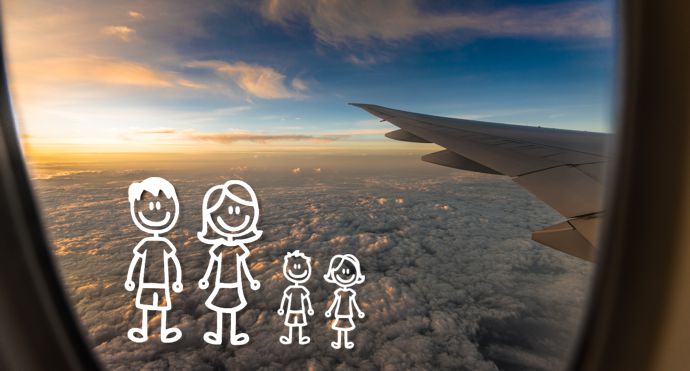
A year and a half ago, I wrote about Traveling with Young Children. Based on experiences flying around the world with my (then) 3- and 1-year-old, I had an overall positive perspective on how little ones could coexist with a wanderlust lifestyle.
Well, we are now in 2017, when everyone seems to be grumpier about everything all the time. To go with the flow, I’m offering a follow-up post with a more pessimistic tone.
No, this isn’t about how your vacation will be more tiring than work. Or how embarrassed you may be when your kids misbehave in a foreign country. Or that you can’t dine at a 3-Michelin-star restaurant because of its adults-only policy.
This post is about how, when it comes to the logistics of trip planning, the system is rigged against can seem poorly designed to support the parents with young children.
GLOBAL SEMI-ENTRY
However much you and I may think of all toddlers as terrorists, the only thing they are capable of damaging is their parents’ sanity. I mean, we’re talking about people who can’t even stab a piece of carrot with a fork yet… that’s the definition of harmless. If the Department of Homeland Security (DHS) used just a bit of common sense, you’d think that they grant automatic (and free) Global Entry status to every passport holder under a certain age.
But of course, DHS and common sense don’t belong in the same sentence…
Two years ago, I rolled my eyes as I carried a toddler and a newborn to the Global Entry “interview”. They paid the full application fee, were deemed not to threaten America, and have been re-entering this country through the fast lane since. Well, sort of. We’d go through the fast lane, but it was never as fast as promised.
The problem is that we have a sloppily designed Global Entry system. Biometrics (i.e. fingerprint) are not taken for minors during the application process. Then, upon each re-entry into the Land of the Free, the kiosk would attempt to process as normal, prompt for photo, and immediately freak out with a “no biometrics on file” error. Then, you get a print out with a giant X, above an awkward photo of you bending down to pick up the child, which is taken a second after the machine gives you a 10-second prompt for that photo.
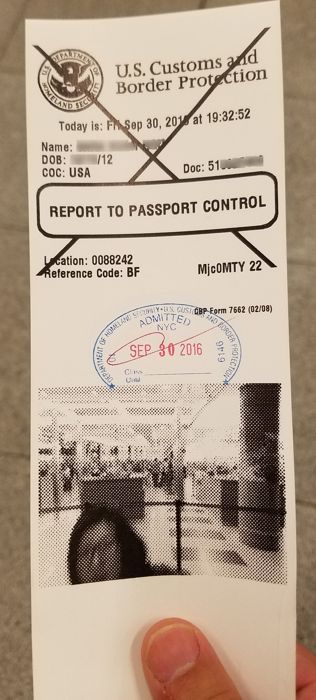
I’m sure this slip does not look suspicious at all
When you apply for Global Entry, do you expect to talk to a human TSA agent every time? Well you’d better, if you travel with kids. Depending on your port of entry, how dangerous your little ones look, and whether the agents on duty had their lunch yet, the next steps can vary. They may roll their eyes and wave you through, or they may carefully read through and scribble in of each of your family members’ passports. At times, this process made us feel more scrutinized and more stressed out than if we didn’t have Global Entry.
If the DHS had any common sense (yeah, again), you’d think that its programmer would add a single line of code to bypass the biometric step, for all young travelers who by design do not have them on file. Instead, despite the $100 application fee, each underage Global Entry holder always gets flagged by the system as potential trouble.
NO SEAT FOR THAT INFANT
As I noted in the previous post, one great aspect of traveling with very young children is that they may fly free (domestic) or very cheaply (international). I love free. But the lap infant benefit can lose its appeal at times. Maybe your child is close to the 24-month mark and already heavier than a 3-year-old. Maybe you’re looking at a 12-hour flight and needing to rest. Maybe you’re trying to book a promotional fare that has to be purchased in multiples of two seats. Or maybe you prefer the kid to be strapped in a car seat for safety. There are countless reasons why you might want to pay extra and buy a seat for your little one(s).
You can definitely do this, but it may not seem obvious. Many airlines’ online booking systems assume that a child under 2 will always sit on a parent’s lap. To get your infant a seat on these airlines, you would have to call in – and verbally spell out your entire family’s first, middle, last names, dates of birth, frequent flyer numbers, credit card number, etc. It can be a huge hassle even if the rep keys in everything exactly right. Or it can be worse!
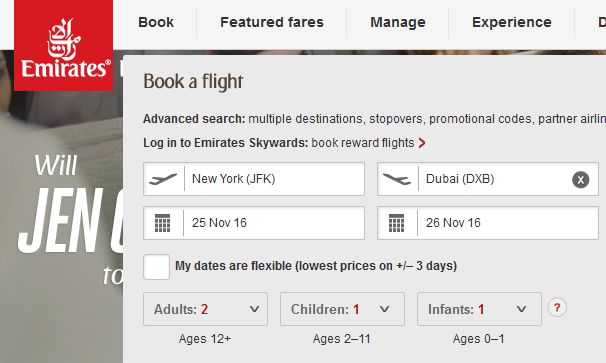
Emirates is among those airlines. This tiny lack of online feature had me on the phone for 2 hours across 3 calls to get our ticket booked.
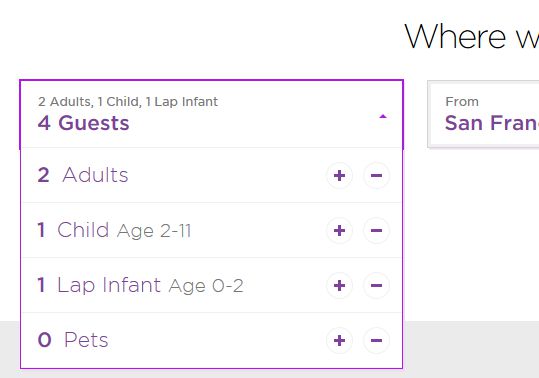
Virgin America’s website lets you book your pets on a flight, but not buy a seat for your infant
EXPONENTIAL PAPERWORK
Part of this is obvious – more people, more paperwork. A group of four travelers needs four passports, four immigration forms, four Global Entry cards, etc. How a traveling family differs from a group of traveling friends is that little kids can’t exactly handle their own stuff. The parents (likely just one of them) end up processing everything multiple times.
It gets worse when you visit a country that wants to know all about a visitor’s family. China’s visa application, for example, asks each applicant for the full name, nationality, occupation, and relationship of all his/her family members. If you are single, nothing needs to be filled out. A married couple would write down each other’s information, so two sets of records. A family of four? Twelve such records. The question may seem innocent, but the effort required to answer it increases exponentially for families.
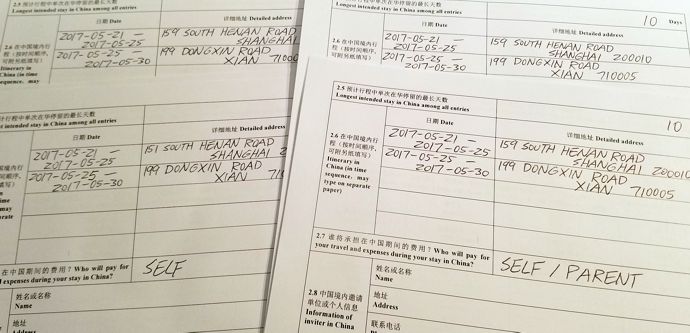
Four Chinese visa applications, with handwritten itinerary repeated four times
SECOND CLASS FREQUENT FLYERS
Any BoardingArea reader should know better than allowing anyone to get on a plane without its miles being properly credited to a frequent flyer program. Kids, of course, are no exception. As a parent, though, the trouble isn’t just about having extra sets of loyalty accounts to keep track of. It can be significantly more difficult to even get your kids signed up.
This is particularly true with U.S.-based programs, due to some federal law intended to protect online privacy of children. Each program executes the rules a bit differently, but generally (1) allows opening account for minors only via phone or fax, (2) does not enable online access of these accounts.
I definitely did not enjoy having to track down (and learn to use) a fax machine just so that my children’s 25% miles flown wouldn’t go to waste. It got worse from there because, without an online login, there was no effective way for me check the balances in these accounts. When I found out that our recent China Eastern miles were not properly credited to my or my wife’s Delta accounts, I assumed the same for the kids but could not verify. Additionally, it wasn’t easy to figure out how to request missing miles for them. I eventually took care of business, but that was a lot of seemingly unnecessary effort.

The error message you’d get on Delta.com when attempting to register for a minor
NO ROOM FOR THE KIDDO
My kids love hotels. My wife and I also loved hotels when we were little. But do hotels love us back? I’m not so sure.
If you travel as a family of four or more, and want to properly disclose the full headcount up front, your lodging options can be limited. For example, here were the results on hotels.com for Milan, when I searched for rooms for two adults and one child:

Plenty of options all over town!
Now, when I added the second child to the query, the results were far less welcoming:
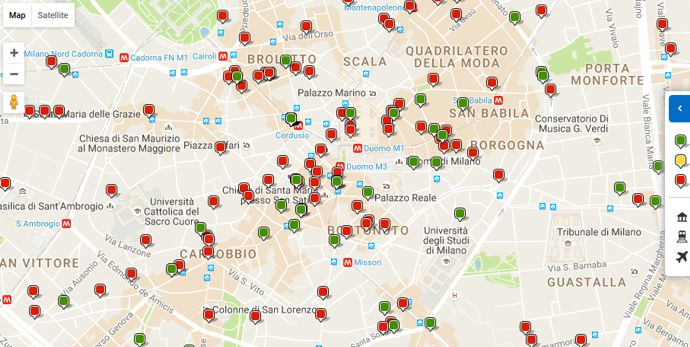
Half of the hotels with rooms for 3 did not have anything for a slightly larger family
Now, I recognize that all hotel rooms are rated for maximum occupancy, which may be tied to company policy or local law. Nevertheless, it can be frustrating to have options so severely limited. The reality, also, is that some little kids take up virtually no space. My two kids and I have a combined weight less than 30% of Americans! It seems absurd that a room can accommodate three large adults, but not two skinny adults and their tiny children.
Of course, you have options of (1) just book a hotel that does allow 4+ travelers, (2) lie about not being thorough with the headcount at time of booking, or (3) contact the hotel to ask for an exception. Depending on your situation and how strict the property manager is, none of these may be ideal.
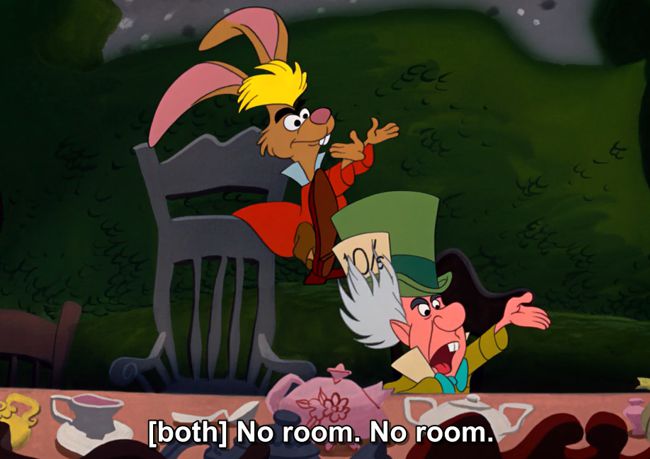
Alice’s unpleasant attempt to join a tea party with a maximum occupancy of 3
To be fair, I’d be perfectly understanding if we’re talking about those 200-square-foot Tokyo hotel rooms. If it’s physically impossible for us to fit, let’s not stay there. But more often than not, I find lower guest allowances at the nicer hotels, which tend to have more space in each room. For example, Park Hyatt Abu Dhabi offers a luxurious standard room that out-sizes many NYC apartments. Guess what? Its 538 square feet won’t be enough for your second child…

This is among the largest hotel rooms I’ve ever stayed at. Nonetheless, it’s capped at 3 guests.
If you’re traveling as a family of four? The property has something for you as well… with 1,614 extra square feet and 15 times the nightly rate! If you are someone who prefers to follow the rules, you may be unable to stay at an otherwise affordable property due to its twisted pricing against kids.

If you routinely stay at $4,000 hotels, however, you probably don’t worry about people discriminating against your kids
SHARING NO RIDES WITH TODDLERS
Laws in many U.S. states and foreign countries exempt children car seat requirement for taxis, especially for short rides on city streets. This makes practical sense, because proper safety restraint can be impossible for the traveling family to carry around. Whether your kids should ride without a car seat is up to your risk tolerance, though I imagine many avid world travelers don’t get too bogged down by low-probability events.
We now live in an age where Uber and Lyft have largely replaced taxis. However, ride shares are not licensed taxis and such legal exemptions do not apply to them. If an Uber driver gets caught transporting a child without a car seat, he or she will be fined just like the driver of any private vehicle. Because of this, expect ride-share drivers to turn you down when they see you waiting with a little one (unless they are ignorant of the law or choose to turn a blind eye). Depending on where you are, not being able to ride in an Uber/Lyft with your kids can be a minor inconvenience or a severe limitation on your ability to get around.
One exception is Uber Car Seat, an UberX option that comes equipped with a car seat for your child. Don’t get too excited, though, because (1) it’s available only in NYC, where you have an abundance of other transit options; (2) each such car comes with only a single car seat, which doesn’t help if you have 2+ kids; (3) it has very rigid specs on the age, weight, and height of children who may use it. While I appreciate the thought behind this service, I’d say it’s basically useless.
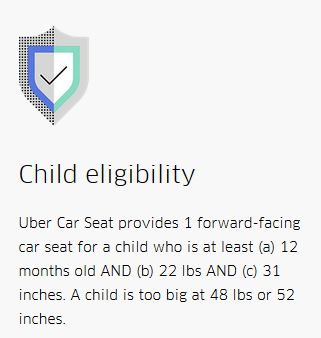
There’s also a $10 surcharge for each of these rides
BOTTOM LINE
Doing anything with young children can be energy consuming, and traveling with them is no doubt among the most difficult. As such, when aspects of travel logistics make it even more difficult for the little ones, they can really drive parents crazy.
Don’t get me wrong, though, as I still find the travel & hospitality industry to be generally accommodating of families. While these issues can be frustrating, in the grand scheme of things they are not overly detrimental to the experience of traveling with young children.
Nice post! I sure have experienced all of these maddening issues.
Amazing post. This post is very important for all Guardian and parents.